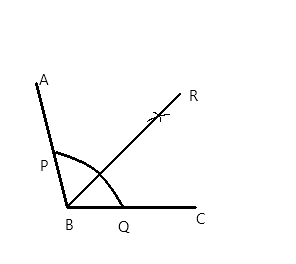
Using a protractor, draw an angle of measure ${108^ \circ }$. With this angle as given, draw an angle of ${54^ \circ }$.
Answer
510k+ views
Hint: Start by drawing the given angle of ${108^ \circ }$ using protractor, the next step is to analyse the next angle they have given us to draw, in this question they have given us ${54^ \circ }$ which is just the half of ${108^ \circ }$, so we can bisect the angle. To bisect the angle, we take radius in the compass and draw the arc from x axis and y axis, the point at which they intersect is the point where ${54^ \circ }$ is obtained, from the origin extending a line to that point.
Complete step-by-step answer:
Step #1: Using protractor, draw an angle ABC of measure ${108^ \circ }$
Step #2: With centre B, and taking any radius, draw an arc, intersecting the ray BA and the ray BC at point D and E respectively.
Step #3: With centre D and radius greater than half of DE, draw an arc inside the angle.
Step #4: With centre E and taking the same radius as in step 3, draw an arc intersecting the arc drawn in step 3, at F.
Step #5: Draw the ray BF. This is the angle bisector of angle ABC. So $\angle FBC = {54^ \circ }$
Step #6: With centre B and taking any radius, draw an arc intersecting the ray BF and the ray BC at G and H respectively.
Step #7: Draw a ray MN.
Step #8: With a centre M and taking the same radius as in step 6, draw an arc intersecting the ray MN at point P.
Step #9: With centre P and taking radius equal to HG, draw an arc intersecting the arc drawn in step 8, at point L.
Step #10: Draw the ray ML.
Angle LMN is the desired angle of measure ${54^ \circ }$

Note: The main motive in this question should be o understand the relation between the angles given to draw, like in this question one of the angle was half the angle that was given, therefore we bisected it once, similarly if they had given us an angle one-third the given angle then we should have bisected it thrice, and so on.
Complete step-by-step answer:
Step #1: Using protractor, draw an angle ABC of measure ${108^ \circ }$
Step #2: With centre B, and taking any radius, draw an arc, intersecting the ray BA and the ray BC at point D and E respectively.
Step #3: With centre D and radius greater than half of DE, draw an arc inside the angle.
Step #4: With centre E and taking the same radius as in step 3, draw an arc intersecting the arc drawn in step 3, at F.
Step #5: Draw the ray BF. This is the angle bisector of angle ABC. So $\angle FBC = {54^ \circ }$
Step #6: With centre B and taking any radius, draw an arc intersecting the ray BF and the ray BC at G and H respectively.
Step #7: Draw a ray MN.
Step #8: With a centre M and taking the same radius as in step 6, draw an arc intersecting the ray MN at point P.
Step #9: With centre P and taking radius equal to HG, draw an arc intersecting the arc drawn in step 8, at point L.
Step #10: Draw the ray ML.
Angle LMN is the desired angle of measure ${54^ \circ }$

Note: The main motive in this question should be o understand the relation between the angles given to draw, like in this question one of the angle was half the angle that was given, therefore we bisected it once, similarly if they had given us an angle one-third the given angle then we should have bisected it thrice, and so on.
Recently Updated Pages
What percentage of the area in India is covered by class 10 social science CBSE

The area of a 6m wide road outside a garden in all class 10 maths CBSE

What is the electric flux through a cube of side 1 class 10 physics CBSE

If one root of x2 x k 0 maybe the square of the other class 10 maths CBSE

The radius and height of a cylinder are in the ratio class 10 maths CBSE

An almirah is sold for 5400 Rs after allowing a discount class 10 maths CBSE

Trending doubts
The Equation xxx + 2 is Satisfied when x is Equal to Class 10 Maths

Why is there a time difference of about 5 hours between class 10 social science CBSE

Change the following sentences into negative and interrogative class 10 english CBSE

Write a letter to the principal requesting him to grant class 10 english CBSE

Explain the Treaty of Vienna of 1815 class 10 social science CBSE

Write an application to the principal requesting five class 10 english CBSE




